A.J.S. Rayl • Jun 06, 2017
Mars Exploration Rovers Update: Opportunity Shoots the Moon on Arrival at Perseverance Valley
Sols 4717 - 4746
In another dynamic demonstration of what can be achieved when a team works together, Opportunity cruised to the top of Perseverance Valley in May, shot the moon, and drove the Mars Exploration Rovers (MER) mission into its 160th month of surface operations.
Perseverance Valley is a place unlike any the MER mission has visited and the rover’s arrival there represents a magnificent achievement. “We’ve proved through lots of perseverance that we could make it and we have arrived,” announced MER Principal Investigator Steve Squyres, the James A. Weeks Professor of Physical Sciences at Cornell University. “It’s so new and so different. And it’s really, really cool.”
Cutting west to east and forming a broad notch in Endeavour Crater’s western rim at Cape Byron, “the valley stretches downhill for the length of about two football fields, around 720 feet or 220 meters, top to bottom, on a slope of about 15 to 17 degrees,” said Deputy Principal Investigator Ray Arvidson, Washington University St. Louis.

The MER team members had been checking out Perseverance for years in images taken from cameras onboard the Mars Reconnaissance Orbiter (MRO). With their robot field geologist on site, firing away with her Panoramic Camera (Pancam) and Navigation Camera (Navcam) and sending home dozens of ‘picture postcards,’ they are finally able starting to see this once impossible dream location up close.
From the edge of Endeavour’s rim, right at the lip at the top of Perseverance Valley, Opportunity, like any tourist would, took in the views all around her. “The idea was to park right at the high point and look inside the crater at the initial part of the valley, and then look back or behind at what appear to be a set of channel features that converge toward the lip,” said Arvidson, the James. S. McDonnell Distinguished University Professor in the Department of Earth and Planetary Sciences at WUSTL.
In the midst of imaging the landscape, Opportunity paused to shoot the moon. Looking skyward with her Pancam at specifically chosen times, the robot aimed to freeze frame the fast-moving Martian moon Phobos as it transited the Sun. It’s an assignment that requires extreme precision in the planning. “You’ve got to be taking pictures in the right place at exactly the right time,” said Mark Lemmon, a MER science team member and “the brains behind the effort,” as Planetary Society President Jim Bell, the science lead on the rovers’ Pancams, defined him.
It’s a challenge that Lemmon, an associate professor in the Department of Atmospheric Science at Texas A&M University, has been taking on since shortly after the MER mission began in 2004. And it’s something Spirit and Opportunity weren’t even designed to do. “These rovers were not sent to Mars as astronomical observatories,” he noted.
But with the MER team’s support, Lemmon and the rovers have managed to capture images of Phobos and Deimos some 30 times all told to date. “I've been a big fan of ‘bonus science’ from the Pancams on Spirit and Opportunity since the beginning, and tracking the orbits of the Martian moons is in that category,” said Bell, a professor in the School and Earth and Space Exploration at Arizona State University (ASU).
The images are more than cool pictures. They’re science data that serve to better refine the orbits of the Martian moons, which have been studied from the ground since they were discovered in 1877. This time around, in one split second, Opportunity once again snapped a picture of Phobos’ transit of the Sun that is, simply, stellar.
With the moon shot checked off, one might think that Opportunity would head right into the valley. It is after all the premiere science destination of MER’s tenth extended mission. But the scientists and engineers alike have work to do before they embark on what is to be a one-way trek downslope into Perseverance and to the floor of the crater.
The scientists want the rover to check out targets outside the valley for any kind of evidence that may indicate how this distinctive valley formed; the engineers and rover planners need to review Opportunity’s latest images as well as topographical maps that will be created from them to determine with certainty that their ‘bot will be able negotiate the downward hike into Perseverance.
As a tourist looking over the rim, you’d think: ‘Oh yeah we can make it down that,’” said MER Project Manager John Callas, of the Jet Propulsion Laboratory (JPL), the birthplace of all of NASA’s Mars rovers. “There’s nothing that says, ‘Don’t go into the valley,’ but we need a visual terrain model and established that there is a route down.
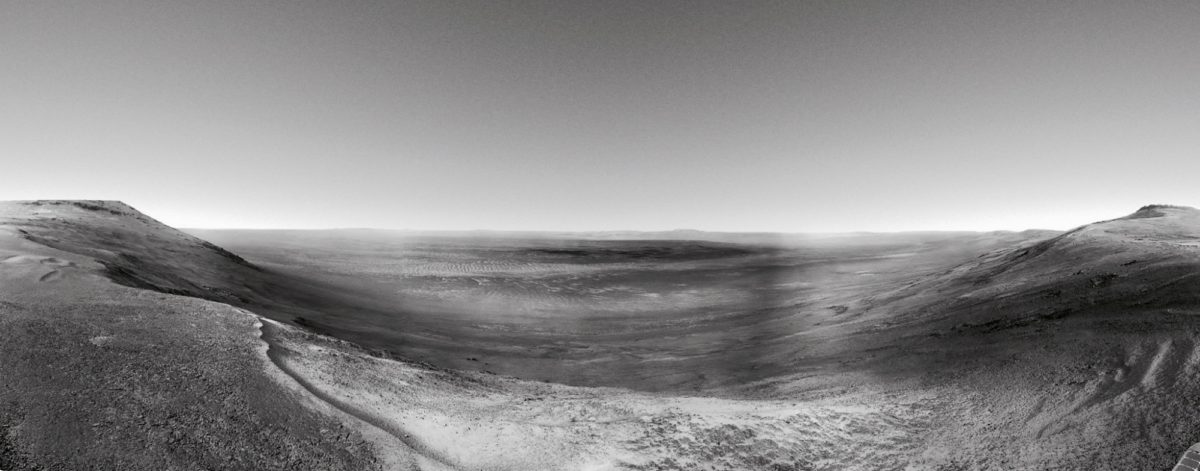
The team wasted no time in creating an agenda. Opportunity was first dispatched to a promontory on the north side of the valley’s top, and then to another promontory on the south side where she took stereo images with her Pancam and panoramas with her Navcam. Those stereo images would be processed at JPL into various maps, and a 3D model that will reveal the topography of Perseverance in explicit detail.
Once those models and maps are complete, MER Rover Planner Paolo Bellutta, the MER route master who has charted Opportunity’s paths since Victoria Crater and a proud American immigrant from Italy, will carefully evaluate the data. With input from science team members on the features they’re keen to inspect, he will determine the rover’s path into and around Perseverance Valley. Beyond figuring out the downslope course, he will be looking for north-facing slopes where the solar-powered robot can soak up as much of the Sun as possible through the coming Martian winter.
All trials and possible tribulations aside, positive attitudes reign on MER. With the Martian winter about to set in however, this journey will not be stress-free. “The rover is dustier this winter than last winter, and while we see north-facing mounds, they’re not the steep slopes that we had at Marathon Valley, so it will get tricky this winter,” said Lead Flight Director and Rover Planner Mike Seibert. Tricky as all the rover planners know it will be, Bellutta remains confidant. “I am optimistic that we will be able to explore this region successfully.”
After finishing work on the stereo imaging, Opportunity departed from the promontory on the south side of the Perseverance overlook. Driving farther south, the rover continued taking in the views with the traditional field geologist’s ‘walkabout,’ documenting the scene with pictures and searching for any geological features that might reveal clues about what carved Perseverance billions of years ago – the Martian mystery the scientists seek to solve.
“Based on what we can see from orbit, we’ve got basically three working hypotheses that we will be testing,” said Squyres. One is that Perseverance was formed as a result of “a process called sapping,” he said, a geomorphic erosion process where water flows downhill, displaces fine sediments, physically and chemically weathers rocks, and creates a valley. Groundwater sapping appears to have created valleys in various locations all around Earth, including in the U.S., England, and New Zealand.
Another possibility is that Perseverance was formed by one or more debris flows, which are “basically slurries of mud and rock lubricated by a little bit of water,” Squyres continued. A third possibility is that “there was a lake out on the plains that spilled over the rim of the crater and flowed down the rim.”
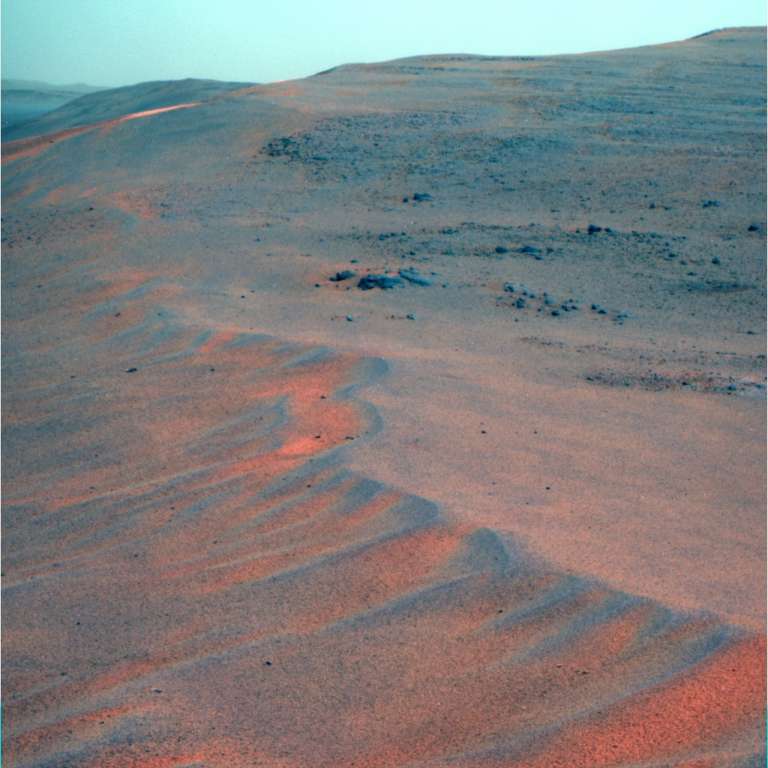
After scrutinizing Opportunity’s latest images, Arvidson, at month’s end, suggested a fourth hypothesis. “The whole valley could be a fracture system coming from the west [where the plains are] cutting through the sill and going down into what’s now Perseverance Valley, all hollowed out by the wind.”
During the walkabout, the scientists will be looking through their rover’s “eyes” for any telltale signs. “In contrast to many walkabouts we have done in the past, where the story we were trying to understand was a chemical one or a mineralogical one, something having to do with the composition of the rocks, this walkabout is all about geomorphology, the landforms,” said Squyres. That means Opportunity will be taking “lots and lots and lots of high-resolution stereo Pancam imaging.”
The rover, as usual, is accommodating all commands. “A real trooper, Opportunity continues to do everything we ask, continues to perform as we expect, and continues to amaze us with its longevity,” said Chief of MER engineering Bill Nelson, of JPL.
“All systems are functioning with their new normal 13 years in,” added Seibert, who after 12 years at the rover “wheel,” will soon be leaving the mission and roving onto other things. “The driving recently has been amazing and May was another clean month for the rover, which is really nice.”
Opportunity first drove up to Endeavour Crater in August 2011 and has been exploring sites on and near the western rim ever since. The big crater, which spans about 22 kilometers (13.67 miles) in diameter, was created by a blistering impact some 3.7 to 4.2 billion years ago, during the Noachian Period. This was an ancient epoch in Mars’ history when water percolated underground, flowed across the surface, and perhaps even formed an ocean.
MER is the first only surface mission to date to study Noachian Period features, and Perseverance probably has deep Martian secrets to share. “This place has the potential to be one of the signature science campaigns of the entire mission,” said Squyres. “And after 13-and-a-half years, that is pretty cool.”
Deep Dive into May
When May dawned on Endeavour Crater, Opportunity could see the top of Perseverance Valley. The rover had begun the final approach into the MER mission’s new science site on the last sol in April and then spent Sol 4717 (May 1, 2017) taking images and tending to the routine business that keeps a robot Martian explorer exploring.
The skies were still hazy as fallout from the regional storms of a couple of months ago continued. The atmospheric opacity or Tau was recorded at 0.883 and Opportunity’s solar array, blanketed with the dust raining down, was only taking in 56% of the sunlight streaming down for power production. Still, the robot was managing to produce energy levels that fluctuated around 400 watt-hours. Not great, but enough for the rover to continue roving and working.
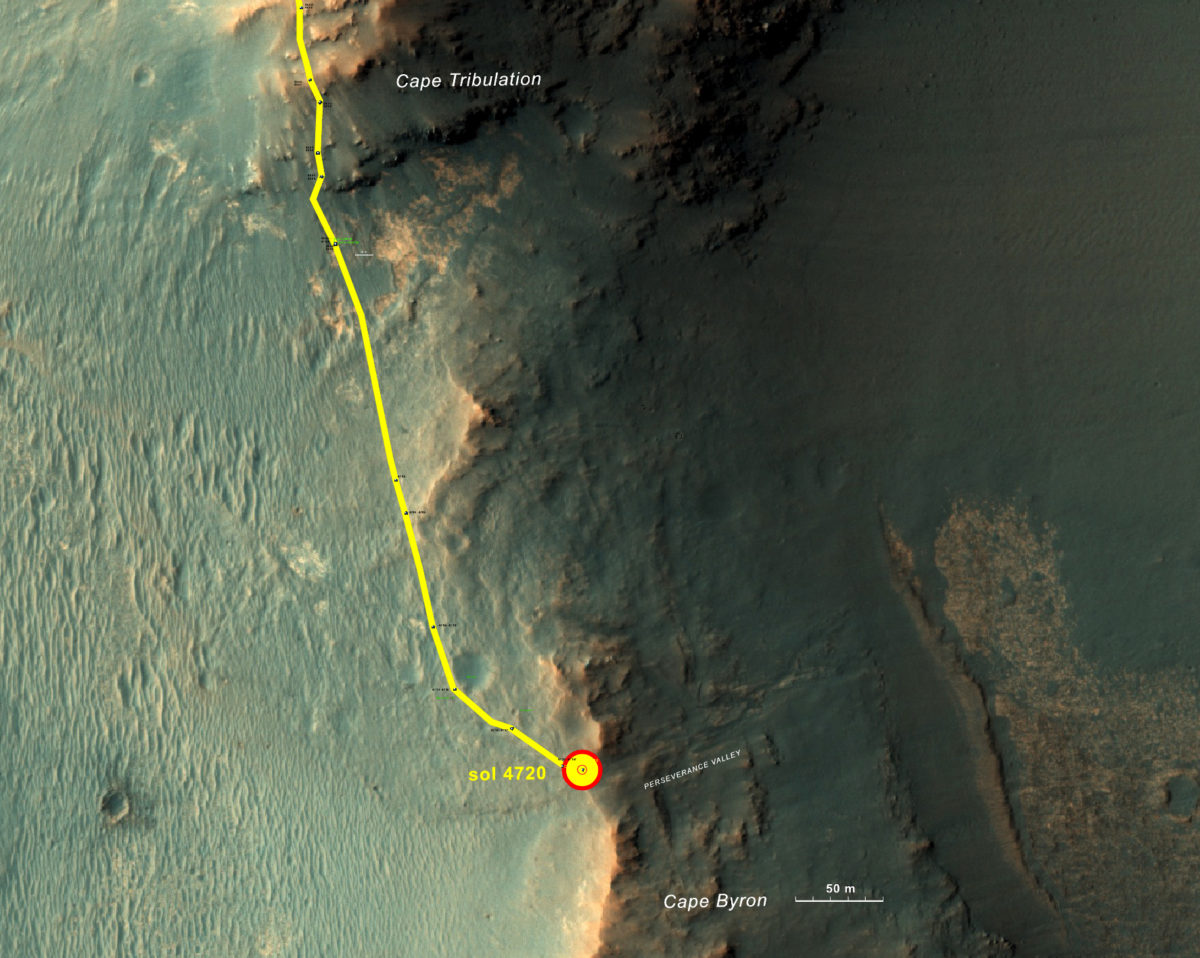
On Sol 4718 (May 2, 2017) Opportunity drove for 32 meters (104.98 feet), to the southeast and into the area atop the valley. “Opportunity could finally see into Perseverance, although it drops off from the top, so the view was limited,” said Nelson. “But that was the sol the rover officially arrived.”
The scientists had spotted Perseverance years ago in orbital images taken by the HiRISE camera onboard the Mars Reconnaissance Orbiter (MRO). “It seemed so impossibly far off,” Squyres remembered. Now, Opportunity was there and another new adventure was about to begin.
Like any field geologist on Earth might do, Opportunity sat on the “lip” of the valley and took in the view, documenting this special sol in pictures. “We wanted to look inside and then behind us, out to the west, the opposite direction from the crater rim,” said Arvidson, who has logged more landed science mission sols Mars than any other scientist, beginning with the Viking missions in the 1970s.
The rover used both her Navcam and Pancam to take panoramas of her surroundings, focusing on the notch in the crater rim where the valley begins to slope downhill, as well as nearby ripples that give texture to the landscape and more distant features. Opportunity then headed west or farther up into the upper area of Perseverance for another perspective. But another opportunity was knocking.

During the next few sols, the rover put on her astronomer’s cap. With Lemmon’s guidance from Earth, the robot looked to the sky and focused Pancam, at the ready to capture images of Phobos as it transited the Sun. Just like on Earth, Mars has eclipse seasons. Once a year, or twice every Mars year, there is an eclipse season on the Red Planet and usually Opportunity has the chance to shoot one of the Martian moons.
Mars is the only one of the four rocky, terrestrial planets in our solar system that is endowed with two moons. They were discovered in 1877 by American astronomer Asaph Hall with what was then the largest refracting telescope in the world, a 26-inch telescope at the United States Naval Observatory.
The potato-shaped moons were promptly named after twins Phobos (Fear) and Deimos (Panic), who in Greek mythology, accompanied their father Ares, the god of war, into battle. [The Romans knew Ares as Mars and that’s the name that stuck for the planet that ‘burned’ red in the night sky.]
Phobos is the larger of the two moons, measuring about 22 kilometers (13.67 miles) across. It orbits just 6,000 kilometers (3,728 miles) from Mars and travels around the planet three times a day, zooming across the Martian sky approximately once every four hours. Deimos is just 13 kilometers (about 8.08 miles) across and orbits the Red Planet from a distance of about 20,069 kilometers (about 12,470 miles) about every 30 hours, which is a little more than a Martian day.
For Opportunity – and Spirit back in the day – capturing an image of Phobos or Deimos from the surface of Mars is, and always was, about more than just getting a cool shot of a moon orbiting by in the sky, but about collecting valuable scientific knowledge. The goal is to track the moons’ orbits. “The more precisely you know the orbits, the easier it is to constrain the long-term evolution of Phobos and Deimos, which tells you something about the interior of Mars and maybe the inside of the moons,” explained Lemmon. “It also makes it easier to “precisely point” the hi-resolution cameras on the orbiters so they can also freeze frame the small moons.
Scientists have been tracking the orbits of Phobos and Deimos from the ground since Hall discovered them and Lemmon, with the MER rovers, has been tracking the moons’ orbits since 2004. “We’re trying to come up with a very long baseline, long time period of having high-quality Phobos/Deimos observations, where we could say Phobos was orbiting exactly in this direction,” said Lemmon. “The Sun is the easiest backdrop for that.”
When Phobos is between the rover and the Sun, “you can pinpoint it,” he continued. “And that is more precise than almost any other observation that could be made and more precise than any other observation that is routinely made. That’s why we keep looking at Phobos.”
It’s no small feat. There’s a lot that goes into getting good moon shots with the rover. “It requires a lot more planning than most images and requires techniques that we don’t use very often,” said Lemmon. “Every time we attempt this, we have to review: ‘What did we do last time that worked?’”
The challenges are as intricate as they are intense. For starters, there is an error bar in terms of knowing precisely where the target moon will be, when exactly it will be there, and what, precisely, the rover’s attitude will be. “The trick here is that the Phobos eclipse is going to happen when Nature says it’s going to happen,” said Lemmon. And when it happens, it happens fast. “There is a specific 20-to-30 second window when you can take the pictures, so you have to arrange the rover’s day around the Phobos observation.”
The time of the Martian day or sol matters too. “It’s a very important part of the observation, not just from the standpoint of planning it, but a morning observation actually looks at a different part of Phobos’ orbit than an evening observation,” Lemmon explained. “So when we get more than one observation, the fact that they are a different time of day is a relevant distinction.”
Besides the challenge of aiming the Pancam at the Sun and making sure the rover is in the right spot and at the right attitude, there is the challenge of making sure the rover’s clock is on time. Just like your clock or watch on Earth, the robot’s clock drifts and can be off “by as much as 40 seconds,” said Lemmon. That alone, of course, can be the difference between getting the shot and not getting the shot.
Opportunity’s attitude and clock are updated periodically, and the clock is almost always updated close to a transit time, said Lemmon. Even so, getting the shot requires “a specific kind of communication” during the rover command window. But Lemmon and Opportunity have 13 years of experience going for them.
On the morning of 4719 (May 3, 2017), Opportunity succeeded in catching a partial eclipse at 10:20 hybrid local solar time (HLST). “We measured the clock error after the first event,” said Lemmon.
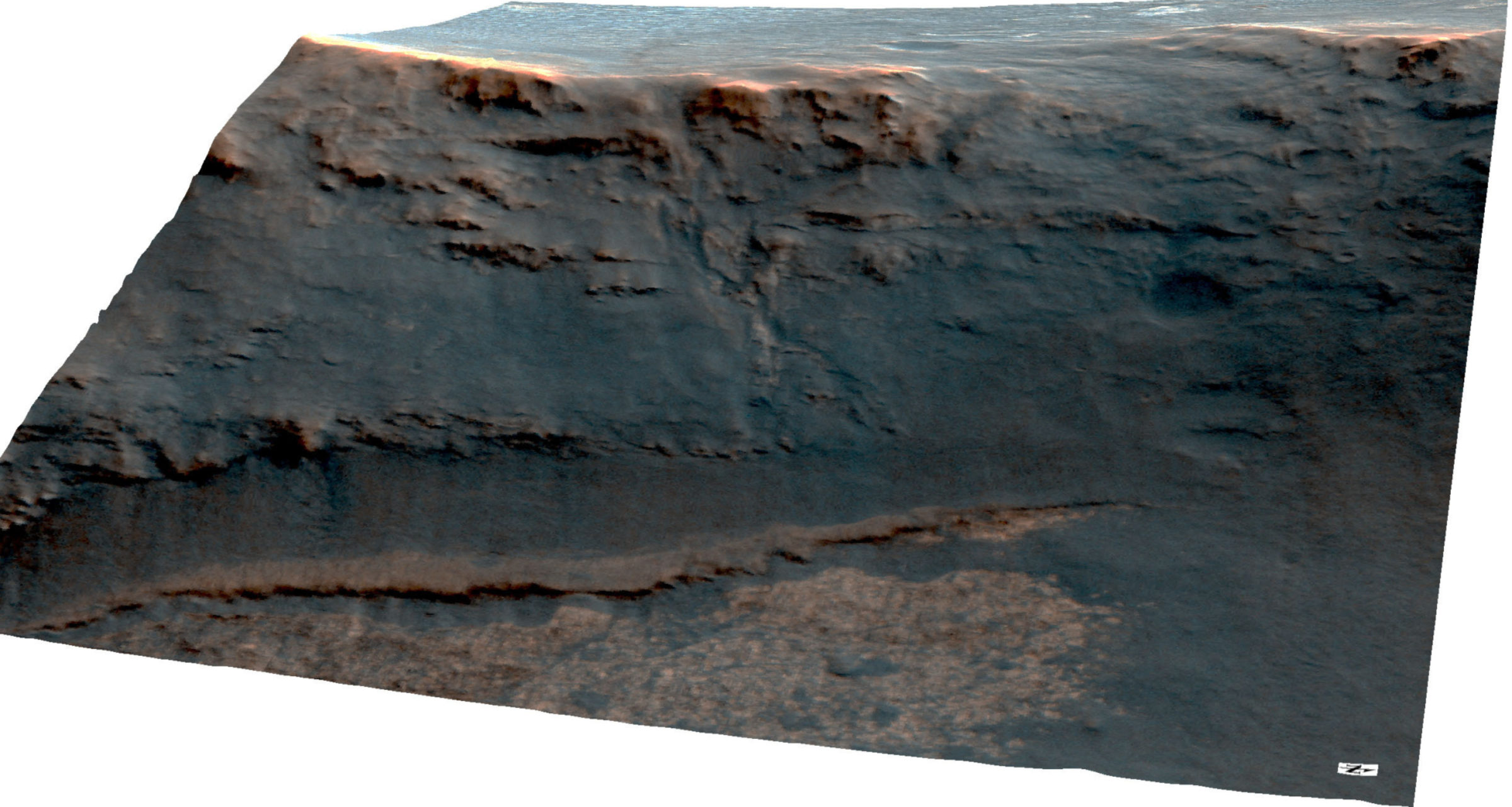
The next sol, the rover changed locations, driving south-southeast 12 meters (39.37 feet) farther into the northern end of the top of Perseverance. From this vantage point, Opportunity would spend several sols taking more Pancam images of this “really, really cool” place,” as Squyres defined it, focusing her cameras on everything in sight.
But the robot was still in astronomy mode. After the drive, Opportunity again looked to the sky, aiming her Pancam to where Phobos would be zipping across the Sun. Late that afternoon, at 16:44 HLST, she captured another partial eclipse. The new location “actually helped the transit images,” said Lemmon. Since the RPs wanted to declare a new site, “the rover’s attitude was corrected and the aim was better.”
The third time is the charm as the saying goes, and on Sol 4721 (May 5, 2017), it proved to be true for Opportunity. When the robot once again turned her Pancam “eyes” to Phobos as it raced by the Sun, the rover pushed the Pancam “shutter” at 14:59 HLST. It worked. Beautifully.
Not long after, a near perfect image of the Martian moon’s transit of the Sun was streaming down to Earth via the Odyssey orbiter and the Deep Space Network. “We nailed it,” said Callas. “This speaks to the fact that not only are we exploring Mars, but wherever we are, we continue to look at the stars to explore the depths of space.”
Opportunity and the MER team are used to challenges. This overland expedition has been an incredible series of challenges from the very beginning. And to some degree, the humans working the mission seem to thrive on finding ways to make impossible things happen.
“Frankly, the main reason I do this is because it’s a very challenging observation,” said Lemmon. “I can’t be a rover driver, but I can do this. It’s just great to have this rover still there and still roving, and to have a team of people who are trying to get every bit of information about Mars that they can, so that they support even things like this.”
This willingness to take on the tough tasks and create never-before-considered workarounds because they are hard is part of this mission’s DNA and along with robots that have proved to be extraordinary testaments to American engineering, it’s why MER has become a legend in its own time.
Opportunity’s successful capture of Phobos in May was the rover’s 19th successful Phobos transit, and 25th by MER; and 30th lunar transit observed by MER when you throw in Deimos, said Lemmon.
The knowledge gained is incremental. “It’s not dramatic. It’s not going to overthrow any scientific paradigm or anything like that,” said Lemmon. “Really what this offers is incrementally better knowledge of Phobos’ orbit and the tidal effect on that orbit. By doing this over a long time period, we get better and better information.”
The observations also are informing, however incrementally, something about the interior of Mars and its “squishiness” or elasticity. “Think about tides on Earth. Our huge Moon raises these ocean tides, but there are also land tides as the surface of the Earth rises and falls with the Moon and we just don’t notice it,” Lemmon pointed out.
Phobos raises a land tide on Mars. Although it is just “a tiny tide,” it deforms Mars by enough to tug on and change Phobos’ orbit over time. “That’s what is being measured,” said Lemmon.
The ultimate goal is to understand how much Mars deforms to change the Phobos’ orbit. “If Mars were perfectly rigid, then Phobos’ orbit would not evolve and Phobos would not be destined to eventually crash into Mars,” said Lemmon. “But because Mars deforms very slightly, the orbit of Phobos will slowly decay and millions of years from now will slam into the atmosphere in a very slow motion process, and crash and burn.” And, he added, “Mars will probably have a small ring system for a little while.”
With celestial mechanics there are some things you can predict. “This is one,” said Lemmon. “You can see the effects on the orbit and those effects come out in the models. There is this one parameter of models that describes the elasticity of the Martian interior. That is basically what we indirectly measure by this long, long record that goes way back, before the orbiters, to the very first observations of Phobos beginning in 1877 when Hall discovered the Martian moons.”
The MER observations are an important addition to this Martian moons databank, because they are far more precise than the observations from Earth. “We now have both this century and a half record of Earth observations and we’re going on a decade and a half of rover observations that are much more precise,” said Lemmon. “So I think we will be able to contribute quite a lot to this.”
It may be painstakingly slow, but every year adds a little bit. With another several years of Mars based observations, Lemmon said, “we should be able to double the value.”
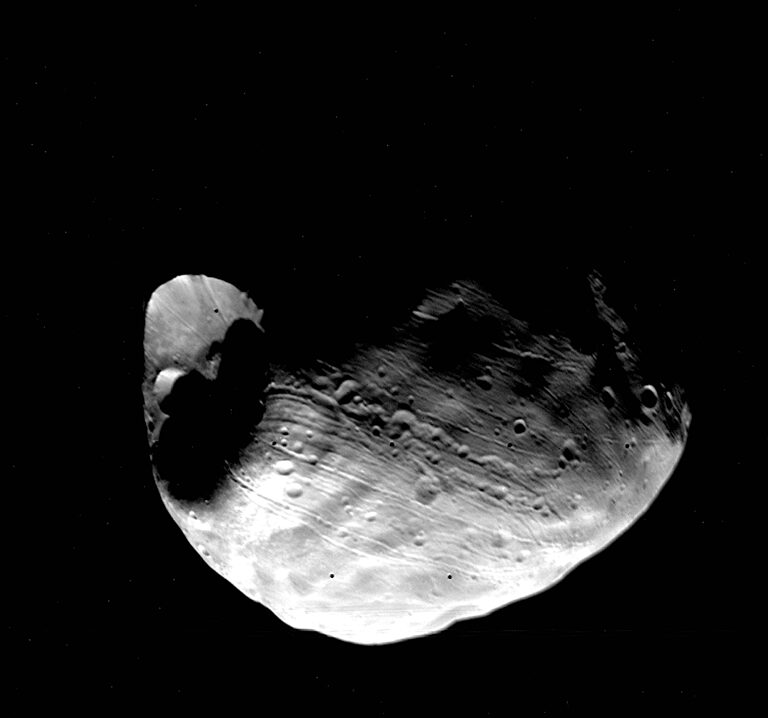
As for Deimos?
“Deimos eclipses from the rover are much more rare,” said Lemmon, for the simple reason that it’s farther away and takes longer to orbit Mars. “We did not get a Deimos eclipse this year, because there was not an opportunity for it. There will be next year.”
The smaller of the Martian moons is particularly interesting because nobody yet has been able to determine its tidal signal. “Deimos should be getting, very slowly, farther away from Mars and its orbit should be evolving as well,” Lemmon pointed out. “But the observations don’t constrain that very well yet. That’s one thing that I’m hoping we can actually improve, and that we will see the tidal evolution of Deimos’ orbit.”
Although Spirit and Opportunity were not designed as robot astronomers, the twin ‘bots have succeeded in contributing to a new baseline of astronomical observations that, “is going to be competitive with a huge baseline of observations from Earth,” said Lemmon. “Our tiny little cameras on Mars are not going to compete with the big telescopes on Earth, but this one little thing we can do better. So we do it.”
The capability of the MER rovers, Opportunity’s continued longevity, and the team’s persistent willingness make this research possible. Once again, it’s because of the MER DNA, in part anyway. “Give us the opportunity and we will maximize the science wherever we are,” as Callas has often put it.
Following the Phobos observation and from the same location atop Perseverance, Opportunity carried on through the second week of May, taking images for an extensive photo survey of the landscape. From Sols 4726 to 4729 (May 10 to 13, 2017), the robot took more than two dozen multicolor Pancam frames and successfully downlinked them to Earth.
Then, on Sol 4730 (May 14, 2017), the rover took off on a 22.7-meter (74.47-foot) dogleg drive to get to a higher point, a promontory that offers a view into the valley below. There, Opportunity settled in to take dozens of images that would ultimately serve to map the new environs.
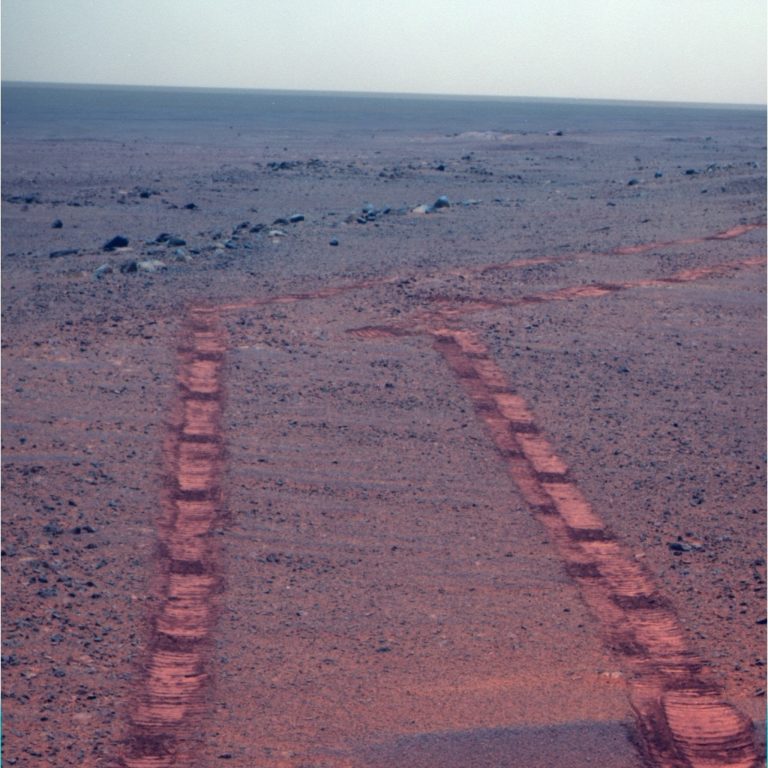
For an assignment known as long-baseline stereo imaging, the robot field geologist was charged with taking Pancam images from two widely separated locations along the overlook for what will be an incredibly realistic, as-if-you-were-there view into Perseverance Valley. Opportunity spent Sols 4731 and 4732 (May 15 and 16, 2017) on the promontory, or Station 1 as the team marked it, collecting the first “eye” of what would soon be processed into the final stereo or simulated 3D image.
“We did extensive imaging at Station 1,” said Bellutta. “The valley appears quite uniform and smooth.” But he couldn’t clearly discern what kind of surface the rover would be roving on. Time and more images would tell. “From orbital imagery, the western portion of the valley looks divided into two parallel channels,” he added. “That is confirmed by the surface imagery.”
As exciting as shooting Perseverance was, Opportunity still had to take care of routine chores. In addition to taking the daily Tau measurement, the rover pointed her Microscopic Imager (MI) up to the sky on Sol 4733 (May 17, 2017) to take some past-due sky flat calibration images. But she quickly returned to surveying the valley, and spent quality time taking the images for a large Navcam panorama.
Once the first “eye” of the stereo images was downlinked to Earth and safely secured at JPL, Opportunity moved on, heading across the overlook on a 3-point "dogleg" drive of 54.77 meters (179.69 feet) to the southern side on Sol 4734 (May 18, 2017). “But we wanted to get into a better imaging position,” said Nelson.
So the next sol the rover drove again and put another 10.45 meters (34.28 feet) in the rear view mirror, Parking at what soon became Station 2, Opportunity hunkered down to take the second “eye” and soon completed the long baseline stereo imaging. Once those images were received on Earth, they were transferred to a team in JPL’s Multi-mission Image Processing Lab (MIPL) for processing into a 3D digital elevation model (DEM) of the valley, and other detailed maps. These models and maps will help the Bellutta chart a safe and productive course that will guide the rover through the valley and through the coming winter.
Because of the long Memorial Day holiday weekend and limited staffing, Opportunity would be at Station 2 for the next 10 sols. Before the humans took their break however, Opportunity sent the second set of the stereo images home – and after more than a year and a half of bit-by-bit datadumps, she also returned the last of the readouts from her Flash or long-term memory drive on 4742 (May 26, 2017).
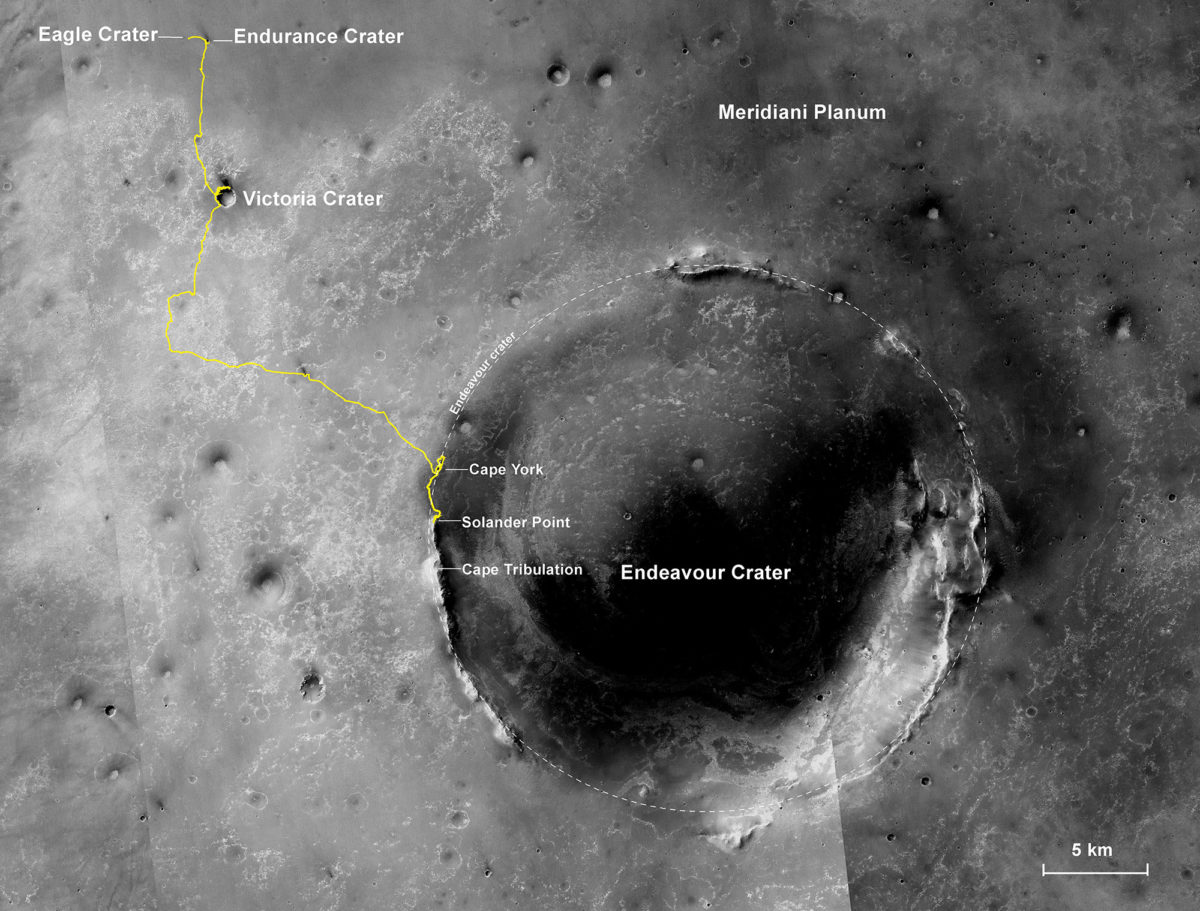
“The read-outs are not the way we would normally access the file system, but everything read-out and gave us data,” confirmed Seibert. “There’s work to be done. We have to go through it and see what we have now that we have the complete image, but this was a big long step to get there.” And this does free up a lot more data room in RAM for science to work with.” This achievement also serves to free up room in the rover’s RAM. Now science and engineering will have 100% of every downlink, “rather than having to try and return bits and pieces of the old Flash system,” he said.
It remains to be seen if Opportunity will ever use her Flash again. The robot has been working in persistent RAM mode for nearly two years. Since RAM is volatile memory, the ‘bot must downlink everything the same sol before shutting down for DeepSleep, or it will be lost. And that’s a challenge with which the team has to contend. “When we get our downlinks, for various reasons, we may not get everything down,” Callas noted. “And if we don’t get all of the rover’s work, we have to take it again, so the science campaigns are more complicated for us,” he said.
That noted, Opportunity and the team have managed to not let it slow them down much. “I’m not going to count on getting Flash back,” said Squyres. “It’s been so long now, RAM is like the new normal. Right now, we’re going to keep doing what we do.”
The Martian winter, which is right around the corner, will further challenge the team. “Last winter we had to stay awake a lot in order to save the day’s data for the downlink passes from the orbiters,” Callas said. “With Odyssey having very late passes, we had to waste a lot of energy and had to schedule recharge sols to make up for that.”
Callas and the team are planning ahead though. For the mission’s eighth winter, they will be requesting more MRO passes, which are earlier in the day, Callas said. “With those, we won’t have to stay awake as long.”
As Opportunity continued taking pictures of Perseverance with both Navcam and Pancam panoramas, she also worked in measurements of atmospheric argon with the Alpha Particle X-ray Spectrometer (APXS), another “bonus science” study that has been ongoing since near the beginning of the mission in 2004.
Soon the MIPL team at JPL will finish the processing of the stereo Pancam images and the team will have a clearer view of what lies ahead. “MIPL generates several products, including 3D position, slope, and roughness maps that can be used to evaluate terrain traversability,” said Bellutta. “They also provide maps to evaluate northerly tilt or how much the terrain is sloped to the north.”
When those models and maps hand, Bellutta will work with the scientists to maximize the Opportunity’s productivity, as well as keep the rover safe and roving through the mission’s eighth Martian winter. “As always, this is a delicate negotiation with science,” Bellutta said. “Once the scientists have identified targets not only I will take into account traversability, but things like: ‘Are there equivalent targets if we miss that one?’ ‘Is the order in which we visit these targets important?’ ‘What kind of observations does science want to do?’ All these things need to be matched against the engineering constraints, like available power, communication, and other restrictions,” he explained. “So it is not really a strict classification of tasks. We all share the same goal.”
Plus, Opportunity will have to find little havens of north-facing slopes where she can soak up as much of the winter Sun as possible if she’s going to be able to work and rove throughout the harsh season. “We see some mounds and things there, but they’re smaller than those at Marathon Valley,” said Seibert. “They’re little rises similar to what we saw driving back up Cape Tribulation after getting down to Spirit Mound. “We might be able to scoot between them but we’re not seeing any long tens of meters north-facing slopes.”
Following a sol of recharging, Opportunity drove out of May on Sol 4746 (May 31, 2017), departing Station 2 to continue a walkabout of the top of Perseverance. The rover headed toward some targeted outcrop and Station 3 about 35 meters away. She put 24.86 meters (81.56 feet) south/southeast in the rear view mirror, bumping her total odometry to 44,855.67 meters (44.85 kilometers / 27.87 miles) before stopping for the day.
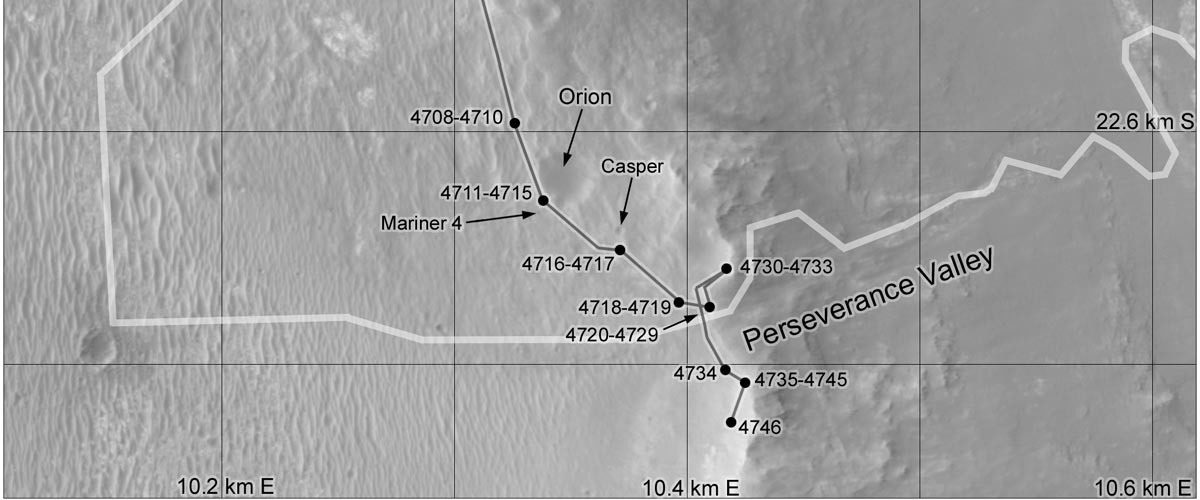
No one is saying exactly when Opportunity will head into the Perseverance Valley, but it will be “at least a few weeks,” said Arvidson. First, the rover will complete the walkabout of the region. “We have to finish everything up around here before we enter the valley because we’re not coming back out,” he said.
“We want to make sure we’ve done a comprehensive job here, outside the valley, and the best place to test lake spillover hypothesis is outside the valley and right at the lip,” added Squyres. To that end, the scientists will be looking for “little channels, scour marks, and erosional features carved by the flow of water,” he said.
With the superior conjunction (aka solar conjunction) and the routine two-week communications blackout coming up in July, and the Martian winter setting in not long after that, the rover and the team have no time to dawdle. The scientists are “jazzed at starting to see this area up close” and to be “looking for clues to help distinguish among multiple hypotheses about how the valley formed,” as MER Project Scientist Matt Golombek, of JPL, put it. But from what they’ve seen so far, “everybody is scratching their head,” said Arvidson.
So the MER scientists have their work cut out for them in the short-term and throughout the harsh, winter season. “We won’t be able to see the details of the candidate channel systems to test whether they’re just simply fractures or channels formed by fluid flow until we get up-close and personal to them in the next few weeks, and, we won’t be able to see the details of Perseverance Valley until we drive into it,” said Arvidson.
“All of the hypotheses are in play right now,” Squyres underscored. “I really am trying to keep a very open mind here. We worked really hard to formulate these hypotheses and worked really hard to come up with specific tests that we can apply. We haven’t begun to apply any of those tests for any of those hypotheses yet. It’s too early. The thing to do at this point is to keep an open mind and just let Mars tell the story.”
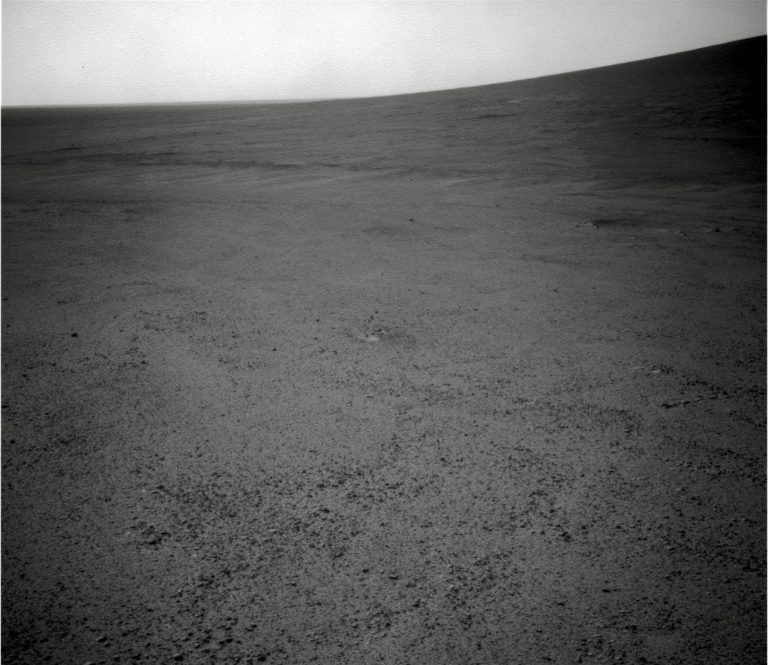
As the Sun set on May, Opportunity’s power levels were fluctuating around 375 watt-hours. Good enough for now. “But there is always concern about winter,” said Callas. “It also speaks to the challenge ahead of being in persistent RAM mode. This winter will be challenging, but we’re going to as we have always done, work to really eek out the most science we can get on every single sol.”
The team however is also facing challenges on Earth, “the reality of a reduced budget,” said Callas. “Between vacations and our limited staff of people, and with Mike Seibert leaving, the result is that we now have what are known as RP-free days, where we will have no choice but to stay put and do what we can do where we are,” said Nelson.
Opportunity presses on, undaunted, as the best of robots always are. The rover’s parts, of course, are an integral part of the ‘bots amazing longevity. Consider this factoid: the azimuth motor on the Pancam Mast Assembly (PMA), which controls the movement for the camera or rover “eyes,” has clicked past 100 million revolutions. And get this: “Our engineering measurements on this motor show no sign of imminent failure, or degradation,” said Nelson. “Whatever degradation there may be, it’s not showing up in any of the telemetry we’re getting.”
There’s more. Even if that azimuth actuator should fail, it won’t stop the action on Mars. Opportunity would still be able to look all around, simply by turning. “It’s going to take a lot to stop this vehicle,” said Squyres. “Right now the rover is doing just great. We’ve lost two instruments since landing, the Mossbauer and the Mini-TES, our mineral detectors. But the beauty of this problem, this scientific question that we are trying to answer in Perseverance Valley, at its core, is a morphology problem,” he said.
In other words, the Martian mystery before them has to do with the landforms, the topography, the details of the sediments, and what one might be able to see in microscopic images, and doesn’t really have a significant geochemical or mineralogical component to it. So, said Squyres, “our tired, beat up, two-instruments-dead rover is every bit as capable of solving this problem today as it would have been 13-and-a-half years ago.”
Stay tuned.
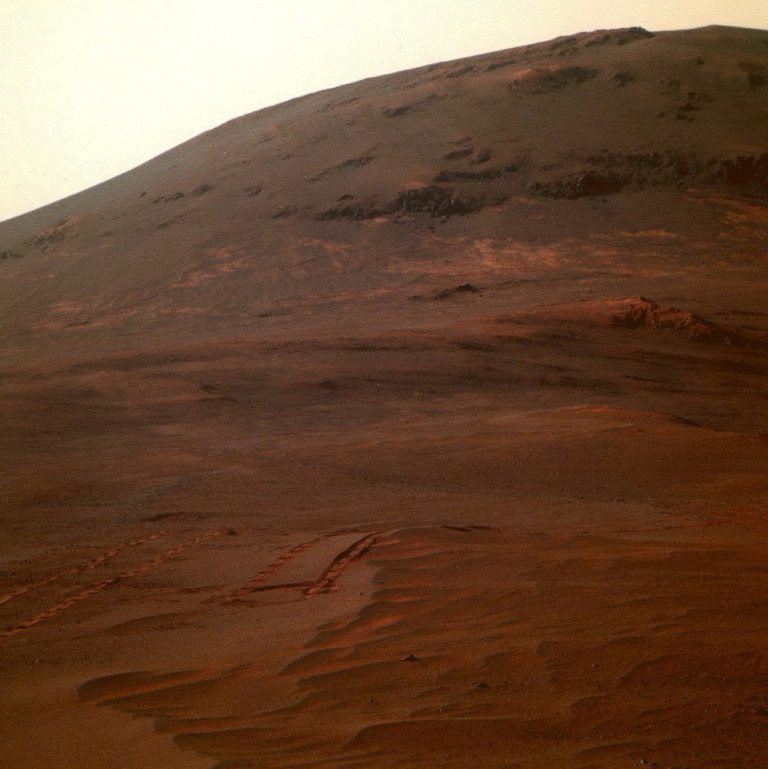


 Explore Worlds
Explore Worlds Find Life
Find Life Defend Earth
Defend Earth


